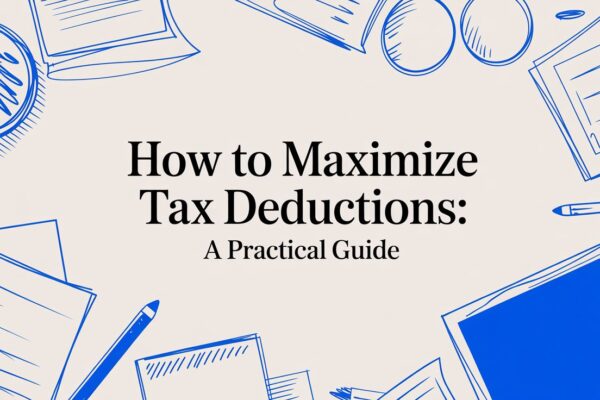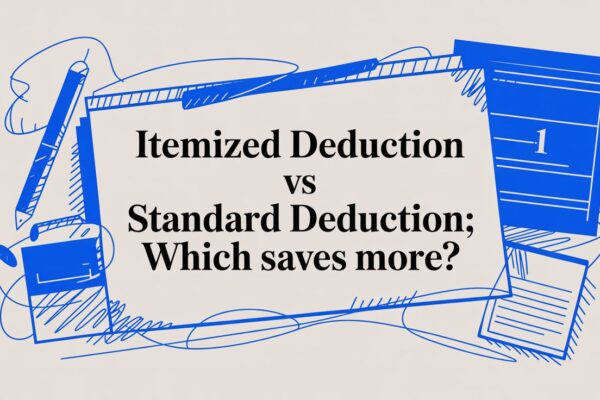-
 11/14/2025
11/14/2025Unlocking Your Clothing Donation Value
Donating clothes does more than just clear out closet space—it can actually lower your tax bill in a meaningful way. But heres the secret most people miss: the clothing donation value isnt what you paid for the items. It’s their Fair Market Value (FMV) at the time of donation, and getting that right is the
-
 11/8/2025
11/8/2025How to Maximize Your Tax Deductions: A Practical Guide
Lowering your tax bill isnt about uncovering some secret loophole. Its about smart, consistent financial habits you build throughout the year. The biggest key to maximizing your deductions often boils down to a single choice: take the simple standard deduction, or itemize your expenses? For a growing number of people, it’s the carefully tracked charitable donations that
-
 11/7/2025
11/7/2025Itemized Deduction vs Standard Deduction: Which Saves You More on Taxes?
When its time to file your taxes, one of the biggest decisions youll make boils down to a simple question: which deduction method will save you the most money? On one hand, you have the standard deduction—a fixed, no-questions-asked dollar amount set by the government that instantly reduces your taxable income. On the other, you
11/16/2025
Mastering Charitable Donation Receipt Requirements: A Guide to Maximizing Your Tax Deductions

If you want to claim a tax deduction for your generosity, you’ll need more than a simple thank-you note. The IRS has very specific charitable donation receipt requirements, and that little piece of paper is your official proof. Without the right documentation, your well-intentioned gift might not count when it’s time to file, meaning you could miss out on significant tax savings.
Understanding Your Donation Receipt Essentials
Maximizing your itemized deductions starts with knowing what makes a donation receipt legitimate. Think of it as a formal record for tax purposes—one that proves your contribution. A quick email confirmation often isn’t enough; the IRS is looking for specific details to verify your gift.
Getting this right is a bigger deal than you might think. The IRS has gotten much stricter about these rules, sometimes denying deductions just because a receipt was missing a key piece of information. And with individual donors giving an incredible $319.04 billion in 2022—that’s about 64% of all charitable giving—it’s clear that proper paperwork matters for millions of taxpayers.
Core Elements of a Compliant Receipt
Every valid receipt, whether it’s for a cash gift or a bag of used clothes, has to include a few non-negotiable details. This keeps things clear for you, the charity, and the IRS.
Here’s what to look for:
- The full name of the charitable organization.
- The date the contribution was made.
- A description of what you donated (e.g., the cash amount or a list of non-cash items).
- A statement confirming whether you received anything in return for your donation.
This decision tree gives a great visual breakdown of what you need for both cash and non-cash donations.
As you can see, a formal acknowledgment from the charity is always the first step, no matter what you’re giving.
Why Every Detail Matters
Letting the details slip can put your deduction at risk if you ever face an audit. For example, if you attend a fundraising dinner where the charity provides a meal, your receipt must include a good-faith estimate of the meal’s value. You can only deduct the portion of your gift that exceeds the value of what you got back.
This is just one of many little rules that make careful record-keeping so important. To get a better handle on which of your contributions count, check out our guide on what donations are tax deductible.
Trying to keep all these details straight for dozens of donations can feel overwhelming, especially when you’re dealing with all sorts of non-cash items. This is exactly where modern tools come in to replace outdated methods. DeductAble ensures every contribution is logged with the right details from the get-go, building a solid foundation for your tax filings and helping you maximize your itemized deductions.
The Critical $250 Written Acknowledgment Rule
When it comes to charitable giving, the $250 mark is a huge deal in the eyes of the IRS. Once a single donation hits this threshold, the rules for proving your generosity get a lot stricter. A simple bank statement or a canceled check just won’t cut it anymore.
And “contemporaneous” means you need to have this document in hand before you file your taxes for the year. If you don’t, the IRS has the right to disallow your deduction, even if you can prove you made the payment.
What Must Be Included in the Acknowledgment
To be compliant, this written statement has to include several key pieces of information. It goes far beyond a simple thank-you note to paint a complete picture of your gift for the IRS.
A compliant acknowledgment must include:
- The name of the charity.
- The amount of cash you gave.
- A description of any non-cash items you donated (but not their value—that’s your job to determine).
- A clear statement confirming whether the charity gave you any goods or services in return for your donation.
- If you did get something back, the charity has to provide a good-faith estimate of its value.
This last point is crucial. You can only deduct the portion of your contribution that exceeds the value of whatever you received. For example, if you paid $400 for a ticket to a charity dinner and the meal itself was valued at $100, your actual deductible contribution is only $300. The receipt has to spell this out clearly.
Handling Multiple Donations and Payroll Deductions
So, what happens if you make a lot of smaller gifts? It’s a common question. If you donate $50 every month to the same organization, each donation is treated on its own. Since none of them hit the $250 mark, you don’t need the special written acknowledgment for them. The rule applies to single contributions, not your total giving for the year.
Workplace giving through payroll deductions, however, has its own set of rules. The good news is you don’t need a separate receipt from the charity for every paycheck.
Instead, you can use one of these as your proof:
- A pay stub, W-2, or another document from your employer that shows the total amount withheld for that charity.
- A pledge card from the charity that includes a statement confirming it provides no goods or services in exchange for your payroll gifts.
For these larger donations, the date of contribution is a vital detail. While bank records often prove the date, the IRS allows the official receipt to serve as the record. This is especially important when you consider that in 2024, individuals contributed a staggering $392.45 billion of the $592.50 billion donated in the U.S. A missing date on a key receipt could be all it takes for the IRS to deny your deduction, making proper paperwork absolutely essential. You can dive deeper into these numbers with these charitable giving statistics.
How to Document Non-Cash Donations
Donating items like clothing, furniture, or household goods is a fantastic way to support causes you care about and declutter your space. But when it comes to taxes, the rules for these non-cash gifts are a lot more involved than just writing a check. You can’t just drop off a bag and hope for the best; the IRS expects you to keep detailed records.
The responsibility for valuing and documenting these items falls squarely on you, the donor. The charity’s receipt will usually just give a generic description of what you gave (think: “one bag of clothing” or “various household goods”) without assigning a dollar value. It’s your job to create a detailed inventory and figure out the Fair Market Value (FMV) for each item to back up your deduction.
Describing Your Donated Items
Vague descriptions are a red flag during an audit. Instead of jotting down “kitchen items,” you need to get specific: “four ceramic dinner plates, two coffee mugs, and one stainless steel saucepan.” That level of detail is your best defense.
For every single item, your records should include:
- A detailed description: Be specific. “Men’s long-sleeve cotton shirt” is much better than “shirt.”
- The item’s condition: Use clear terms like “Excellent,” “Good,” or “Fair.” This is absolutely critical for determining value.
- The date of the donation: When did you actually hand it over to the charity?
- The original cost (if you know it): While not always required, it provides helpful context.
- The Fair Market Value (FMV): This is the price a willing buyer would pay for the item in its current state.
Keeping a detailed log, complete with photos, is the gold standard for creating a bulletproof record. This is exactly where manual spreadsheets become a nightmare, especially after you’ve cleared out a whole closet. It’s this tedious, time-consuming process that makes tools designed to automate documentation so incredibly useful.
Determining Fair Market Value
This is often the trickiest part. The FMV isn’t what you originally paid; it’s what that item is worth today. To be deductible at all, an item has to be in at least “good used condition or better,” unless you get a formal appraisal proving it’s worth more than $500.
For example, that designer suit you bought for $1,000 five years ago might only have an FMV of $100 today, depending on its condition and current fashion trends. You can only deduct the $100.
To figure out these values, you can research what similar items are selling for on sites like eBay or by walking through your local thrift store. But let’s be honest, that’s a lot of work. This is another area where dedicated software really shines. Many people still miss the convenience of ItsDeductible, which used to help with this. As a modern alternative, DeductAble takes the frustrating guesswork out of the equation by suggesting appropriate values based on the item and its condition.
For a deeper dive, our guide on establishing clothing donation value walks through more specific examples.
The Power of a Dedicated Tool
Trying to keep meticulous records for every single shirt, book, and piece of furniture can feel completely overwhelming. Juggling spreadsheets, phone photos, and a stack of paper receipts is a recipe for missed deductions and a massive tax-season headache. A dedicated app changes the game.
With DeductAble, you can quickly catalog each item and assign an IRS-compliant value right from your phone. When you’re done, the app generates a clean, detailed report that organizes everything for you. This creates a professional-grade record that stands up to scrutiny, filling the gap left by the now-deprecated ItsDeductible and giving you the confidence that you’ve maximized your itemized deductions correctly. This isn’t just about making things easier; it’s about accuracy and peace of mind.
Navigating IRS Form 8283 for Large Donations
Once your non-cash donations for the year climb past $500, the IRS asks for a bit more paperwork. It’s time to get familiar with Form 8283, Noncash Charitable Contributions. Think of this form not as a hassle, but as the official story you tell the IRS about the significant items you’ve generously given away.

Filing this form isn’t optional—it’s a mandatory step to claim your deduction on these larger gifts. You’ll need to detail how you got the items, what you paid for them, and what they were worth when you donated them. At this level, solid record-keeping shifts from a good habit to an absolute necessity.
The form is broken down into two parts, Section A and Section B, and knowing which one to fill out is the first step to getting it right.
Completing Section A for Donations Under $5,000
Section A is your go-to for any single item (or a group of similar items, like a bag of designer clothes) valued between $501 and $5,000. Let’s say you donated a nice mountain bike worth $800 and a collection of vintage records valued at $1,200. Both of those would get listed here.
For each donation, you’ll need to provide:
- A clear description of the property: Don’t just say “table.” Say “Vintage oak dining table and four chairs.”
- The date you acquired it: An educated guess is usually fine if you don’t remember the exact day.
- How you got it: Simple answers like “purchase,” “gift,” or “inheritance” work perfectly.
- Your cost (or adjusted basis): This is basically what you originally paid.
- The Fair Market Value (FMV): The amount you’re claiming for the deduction.
- How you figured out the value: This could be a “thrift shop value guide” or “comparable sales online.”
Understanding Section B and Qualified Appraisals
When you donate something really valuable—an item or group of similar items worth more than $5,000—the rules get serious. You’ll need to tackle Section B of Form 8283, which brings a new requirement into the picture: a qualified appraisal from a qualified appraiser.
A qualified appraisal isn’t just a quick estimate from a friend. It’s a formal, detailed report prepared by a professional who meets specific IRS credentials. Skipping this step or getting it wrong can put your entire deduction at risk.
The appraiser has to physically sign your Form 8283, and the charity you donated to also needs to sign, acknowledging they received the item. It’s a paper trail that confirms both the donation and its substantial value.
You’ll almost always need an appraisal for items like:
- Artwork or rare collectibles
- Jewelry and antiques
- Real estate
- Shares of stock in a privately held company
Finding the right appraiser is on you. They must be an independent professional—not you, the charity, or the person you originally bought the item from. The appraisal itself has a strict timeline: it must be done no more than 60 days before you make the donation and no later than the due date of your tax return. Getting the appraisal right is the key to locking in those high-value deductions.
Receipt Rules for Special Donation Types
While most of our giving involves cash or a few bags of household goods, some donations just don’t fit the standard mold. These special cases come with their own unique set of rules, and understanding the specific charitable donation receipt requirements is the only way to make sure your generosity is recognized and your tax deduction is secure.
Think of it this way: the more complex or valuable the asset, the more detailed the paper trail the IRS expects. Getting this right from the start saves you from major headaches later and lets you confidently claim the full deduction you’re entitled to.
Donating a Vehicle
Giving away a car, boat, or even an airplane is a huge gesture, but figuring out your deduction isn’t as simple as checking its Blue Book value. The amount you can claim is directly tied to what the charity actually does with the vehicle after you hand over the keys.
The most important document you’ll need is Form 1098-C, Contributions of Motor Vehicles, Boats, and Airplanes. You absolutely must have this form from the charity to claim any deduction over $500.
Here’s the breakdown of how it usually works:
- If the charity sells the vehicle: Your deduction is capped at the gross proceeds from the sale. It doesn’t matter if the Fair Market Value was $2,500; if the car sells for $1,200, that’s your maximum deduction.
- If the charity uses the vehicle: You’re in a much better position here. If the organization puts the car to work for its mission—like using it to deliver meals—you can generally deduct its full Fair Market Value.
- If the charity makes improvements: If the charity makes significant improvements to the vehicle before selling it, you may also be able to claim the full FMV.
Form 1098-C will spell everything out, including the final sale price if applicable. That’s the number you’ll use on your tax return. For a deeper dive, check out our complete guide on donating your car to charity.
Quid Pro Quo Contributions
Ever been to a fundraising dinner or a charity auction? If so, you’ve likely made a “quid pro quo” contribution. This is what happens when you get something in return for a donation that’s more than $75. The receipt rules are very strict here to make sure you only deduct the portion that was a true gift.
The charity is required to give you a written statement that clearly explains the value of the goods or services you received. Your deductible amount is simply the difference. For example, if you pay $200 for a gala ticket and the meal itself is valued at $80, your actual deductible donation is $120.
This good-faith estimate of value must be on your receipt. Without it, you have no way to properly calculate your deduction, and the IRS could disallow the whole thing.
Appreciated Assets and International Giving
Donating stocks or other appreciated property can be a brilliant tax-saving strategy, but it demands careful documentation. For publicly traded stocks, you’ll need a receipt from the charity or the brokerage that details the company name and the number of shares you donated.
Giving to international charities adds another layer of complexity. For any donation over $250 to a foreign charity, the IRS needs a written acknowledgment confirming the amount and that you received nothing in return. Because many international organizations don’t have U.S. 501(c)(3) status, you might need extra proof like equivalency determination letters to satisfy the IRS. This is a big deal in modern philanthropy, as Africa continues to be the most supported region for cross-border donations. You can find more insights on this from fireflygiving.com.
Trying to keep track of all these varied and complex donations is exactly where a digital tool becomes a lifesaver. Instead of juggling different forms and valuation rules in a messy spreadsheet, DeductAble lets you log each specific type of gift with the right details.
Your Digital Secret Weapon for Flawless Donation Tracking
Let’s be honest. Juggling a year’s worth of crumpled receipts, blurry phone photos, and scribbled valuation notes is a recipe for tax-time stress. That old shoebox method makes trying to meet the complex charitable donation receipt requirements feel like an impossible task.
Switching to a dedicated digital system isn’t just a nice-to-have anymore—it’s the only way to feel truly confident and accurate when you file. Think of it as your command center for giving, building an organized record of your generosity so you get every penny of the tax benefit you deserve.
A Central Hub for All Your Giving
Imagine one single, secure place where every single contribution is logged the moment you make it. That’s what happens when you move your record-keeping to a platform built for exactly this purpose. DeductAble was designed to be that central hub, bringing order to what is so often a chaotic paper trail.
A tool like this lets you:
- Log every gift instantly: Whether it’s a check you just wrote or a bag of household goods you dropped off, you can record it right there on the spot.
- Capture visual proof: Snapping a quick photo of your non-cash items provides undeniable proof of what you gave and what condition it was in.
- Store digital receipts for good: Just upload a photo of your paper acknowledgment or a PDF from an email. It’s now permanently linked to that donation record, safe and sound.
This simple shift turns donation tracking from a painful year-end scramble into an easy, ongoing habit.
From Clutter to a Perfect Report
The real magic happens when it’s time to do your taxes. Instead of spending hours digging through files and trying to piece together your giving history, a digital system does all the heavy lifting for you. This is a massive upgrade from old methods, especially for the millions who relied on ItsDeductible before it was shut down.
At the end of the year, DeductAble generates a comprehensive, itemized report that neatly summarizes all your contributions. This clean, professional document has all the details your tax preparer needs, saving them—and you—a ton of time and hassle.
This isn’t just about making life easier. It’s about making sure every single donation, no matter how small, is properly accounted for with the right documentation. When your records are organized, detailed, and instantly accessible, you can file your taxes with the kind of peace of mind that only comes from knowing your deductions are 100% supported and maximized. It’s simply the smarter way to manage your giving.
Answering Your Donation Receipt Questions
Even when you know the basic rules for charitable donations, real-world giving can throw you a curveball. Getting clear answers to those “what if” scenarios is the key to making sure your generosity is properly documented and your deductions are secure.
Let’s walk through some of the most common questions donors run into.
What If a Charity Does Not Send a Receipt?
This one comes up a lot, but here’s the bottom line: the responsibility for proof ultimately falls on you, the donor. For a smaller cash gift under $250, a bank record like a canceled check or a credit card statement will usually do the trick.
But the game changes for any single contribution of $250 or more. For those, a formal written acknowledgment from the charity isn’t just nice to have—it’s mandatory. Without that specific document, the IRS can flat-out disallow your deduction. If you haven’t received one, you need to proactively contact the charity and request it before you file your taxes.
Can I Use One Receipt for Recurring Donations?
Yes, and thankfully, this is a common and perfectly acceptable practice. If you make regular monthly or quarterly donations to the same organization, they don’t have to bombard you with a separate receipt after every single payment.
Instead, the charity can send you a single, consolidated statement at the end of the year. This annual summary just needs to list the date and amount of each individual contribution and include all the other required info, like the quid pro quo statement, to be a valid IRS acknowledgment.
This consolidated approach is a lifesaver for record-keeping, both for you and the charity. It gives you one clean document covering an entire year of giving, which is far easier to manage than a dozen separate receipts.
How Long Should I Keep Donation Records?
The standard rule of thumb for all tax documents, donation receipts included, is to keep them for at least three years from the date you filed your return. That’s the typical window the IRS has to initiate an audit.
However, most financial advisors will tell you to play it safe and hold onto those records for up to seven years. This covers you in more complex financial situations where the look-back period might be longer.
Ready to stop worrying about lost receipts and missed deductions? DeductAble organizes your giving, captures every detail, and builds a perfect report for tax time. Download the app today and see how easy donation tracking can be.